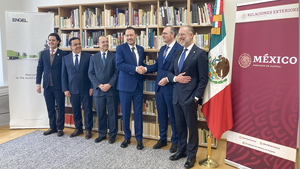Reshoring is dead in its tracks, says A.T. Kearney
Over the past decade, all the arguments for bringing manufacturing back to the U.S. from Asia (reshoring) have been made: Total costs to manufacture, total landed costs (shipping/transportation), quality problems/recalls, intellectual property theft, and the advantages of being close to the U.S. consumer. Made in America is once again a holiday season mantra that the news media, manufacturers and even retailers are chanting.
December 22, 2015
|
People are confusing U.S. companies |
Over the past five years, as the reshoring phenomenon has captured our attention, numerous studies and surveys have tried to gauge whether reshoring is fact or fiction. For example, in 2012, the Hackett Group published "Reshoring Global Manufacturing: Myths and Realities," in which they analyzed the situation, using hard data and another study the group did, "Supply Chain Optimization." The group's findings debunked "a myth about the future of manufacturing" that was being so widely touted: "Manufacturing capacity is returning in a big way to Western countries as a result of rising costs in China."
Even Apple CEO Tim Cook, in a 60 Minutes interview with Charlie Rose on Dec. 20, 2015, denied that most of Apple's products are manufactured in China because of the cost of labor. For the scale of manufacturing that Apple needs, the company needs thousands of people with skills. "China put an enormous focus on manufacturing, in what we would call . . . vocational kinds of skills. The U.S. over time began to stop having as many vocational kinds of skills. I mean, you can take every tool and die maker in the United States and put them in a room [the size] we're sitting in. In China you would have to have multiple football fields," said Cook.
As far back as 2012, the Hackett Group noted that the "reality is that the net amount of capacity coming back barely offsets the amount that continues to be sent offshore," and that is in spite of the group's confirmation that "China's relative competitive position is indeed eroding rapidly, to the detriment of its overall economy."
It would appear that China is experiencing the same realization that U.S. manufacturers had—there's always someplace cheaper to make your products. In a recent conversation with Patrick Van den Bossche, a partner with A.T. Kearney, regarding that company's latest report on this topic ("2015 U.S. Reshoring Index Indicates Manufacturing Reshoring Trend Has Subsided"), he told PlasticsToday that there were a few underlying assumptions early on in the reshoring trend. "One was that a rise in the cost of labor in China would drive reshoring back to the United States, but Vietnam has done a great job of absorbing some of the manufactured goods in which China's labor costs are no longer competitive, such as the apparel industry," said Van den Bossche, co-author of the new report. "When these companies have come back to North America, they've landed south of the border. It is indeed shifting, but has shifted very differently than originally anticipated."
In its "U.S. Reshoring Index" in 2014, A.T. Kearney highlighted that even though manufacturing in the United States was clearly on the upswing, the impact of reshoring was significantly less than what press reports and pundits would have us believe. In fact, the "2014 U.S. Reshoring Index" showed that the rate of reshoring actually lagged that of offshoring. The firm's 2015 index shows that, for the fourth consecutive year, reshoring of manufacturing activities to the U.S. has once again failed to keep up with offshoring.
That fact was noted by the Hackett Group in 2012. It appears not much has changed and reports of manufacturing reshoring are still "anecdotal."
The A.T. Kearney U.S. Reshoring Index also shows that the index has dropped to -115, down from -30 in 2014, representing the largest year-over-year decrease in the past 10 years. "Based on our data, we conclude that the reshoring phenomenon, once viewed by many as the leading edge of a decisive shift in global manufacturing, may actually have been just a one-off aberration," said the report's commentary. "Indeed, the 2015 data confirm that offshoring seems only to be gathering steam, while the U.S. reshoring train that so many predicted has yet to leave the station."
When asked why there seems to be so much disparate information in the media regarding the rate of reshoring, Van den Bossche said he believes this is coming from people "confusing U.S. companies coming back to the U.S. with foreign companies investing in the U.S. "A lot of foreign companies are tapping into the U.S. market primarily because it's still one of the healthiest markets out there," he said. "I think people tend to combine reshoring and foreign direct investment." [See A.T. Kearney's "2015 Foreign Direct Investment Confidence Index."] "These are global companies, not just U.S. companies, that are bringing in manufacturing. We'll see some increase in manufacturing, not from a mass wave of companies repatriating the work, but from countries like China that are putting plants here."
Van den Bossche noted that many surveys of large corporations show that management is "looking at" reshoring. "But, there is a big gap between looking at it and doing something about it. Pulling the trigger on moving a manufacturing plant isn't that easy. It takes a lot to wrap things up and it can be expensive."
Apple's Tim Cook would agree with that. In his interview on 60 Minutes, when asked about why he's not bringing manufacturing back to the U.S., he responded: "Because it would cost me 40% to bring it home. And I don't think that's a reasonable thing to do. This is a tax code that was made for the industrial age, not for the digital age."
Van den Bossche also brought up the skills shortage that Cook mentioned. "There is a skills shortage in the manufacturing market," said Van den Bossche. "Parts of operations will come back but a majority of the activity won't find reshoring that attractive. The skilled labor system—that eco-system of suppliers and research that it takes to be efficient, especially in industries like electronics—is almost all in Asia. To rebuild that in the U.S. would be nearly impossible."
Companies that have moved manufacturing back to the U.S. from offshore locations such as China have "learned the hard way," explained Van den Bossche. "When you make these kinds of moves you have to tread carefully and stay flexible. Additionally, when they reshore where do they go? Seventy-five percent have gone back to their old building and started back up using old machinery, even pulling people out of retirement to operate it.
"Sure, this is a product we can make in the U.S. but now we have to make it on old equipment or invest in new machinery and equipment technology because being competitive requires that. If they don't put in the capital, how competitive can they be? Thank goodness for FDI! These foreign companies are more interested in making the big investment because they are looking for access to the U.S. market, so the payback is a bit different."
Whatever factors may influence reshoring, Van den Bossche says we're not seeing it just yet. "Looking forward to certain elements that influence reshoring, like oil, the dollar and the upcoming elections, none of these are pointing toward reshoring. In fact, those factors are hampering reshoring," concluded Van den Bossche. "Reshoring is pretty much dead in its tracks, and while there is still some anecdotal activity, there's no big wave."
To access the full report, click here.
About the Author(s)
You May Also Like





